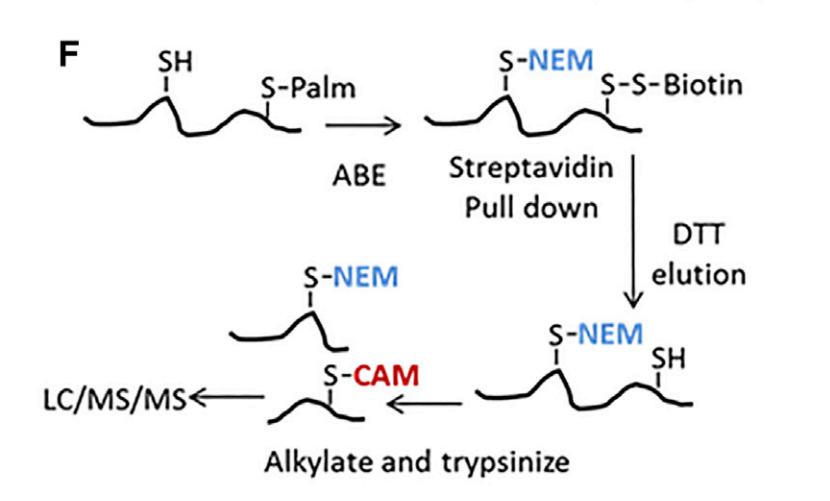博文
[转载]蛋白质棕榈酰化:调控细胞信号传导的关键
||
引言
蛋白质棕榈酰化是一种翻译后修饰,涉及将棕榈酸共价连接到蛋白质的半胱氨酸残基上。这种修饰在蛋白质转运、稳定性和活性中起着至关重要的作用。本文旨在讨论蛋白质棕榈酰化在过去几年中的应用和进展。
蛋白质棕榈酰化的应用
蛋白质棕榈酰化在调节细胞蛋白质的转运、稳定性和活性方面扮演着多种角色[1]。蛋白质棕榈酰化的可逆性使得蛋白质能够在细胞内区域间穿梭,以响应细胞外信号,这使其成为维持稳态和响应细胞外信号的重要机制。蛋白质棕榈酰化已被发现参与了多种细胞过程,包括细胞分化[1]、突触可塑性以及学习和记忆[2]。用于研究蛋白质棕榈酰化的药理工具、动物模型和遗传方法在癌症、传染性疾病和神经退行性疾病的治疗方面具有潜在应用价值[3]。
蛋白质棕榈酰化的进展
近年来,在研究蛋白质棕榈酰化的实验工具方面取得了显著进展。质谱技术的应用使得可以鉴定棕榈酰化的蛋白质以及具体的棕榈酰化位点[4]。点击化学的发展促进了在活细胞中研究蛋白质棕榈酰化和鉴定新的棕榈酰化蛋白质[2]。动物模型的应用使得能够研究蛋白质棕榈酰化在生理和病理过程中的作用[3]。
最近的研究表明,蛋白质棕榈酰化在细胞分化中起着关键作用[1]。蛋白质棕榈酰化的可逆性使得蛋白质能够在细胞内区域间穿梭,以响应细胞外信号,这使其成为维持稳态和响应细胞外信号的重要机制。用于研究蛋白质棕榈酰化的药理工具、动物模型和遗传方法在癌症、传染性疾病和神经退行性疾病的治疗方面具有潜在应用价值。
结论
总之,蛋白质棕榈酰化是一种在蛋白质转运、稳定性和活性中起着关键作用的翻译后修饰。文献综述显示,在过去几年中,在蛋白质棕榈酰化的研究中取得了显著进展,包括发现了棕榈酰基酰基转移酶、鉴定了特定酶对棕榈酰化蛋白质的修饰位点,并利用动物模型研究了蛋白质棕榈酰化。蛋白质棕榈酰化的可逆性使得蛋白质能够在细胞内区域间穿梭,以响应细胞外信号,这使其成为维持稳态和响应细胞外信号的重要机制。用于研究蛋白质棕榈酰化的药理工具、动物模型和遗传方法在癌症、传染性疾病和神经退行性疾病的治疗方面具有潜在应用价值。质谱技术和点击化学的应用促进了在活细胞中研究蛋白质棕榈酰化和鉴定新的棕榈酰化蛋白质。
Citations:
[1]Chamberlain, L. H., & Shipston, M. J. (2017). Protein S-palmitoylation in cellular differentiation. FEBS Journal, 284(1), 2-3. https://doi.org/10.1111/febs.13978
[2]Gao, X., & Hannoush, R. N. (2017). A Decade of Click Chemistry in Protein Palmitoylation: Impact on Discovery and New Biology. Cell Chemical Biology, 25(7), 735-747. https://doi.org/10.1016/j.chembiol.2017.12.002
[3] Main, A. and Fuller, W. (2022), Protein S-Palmitoylation: advances and challenges in studying a therapeutically important lipid modification. FEBS J, 289: 861-882. https://doi.org/10.1111/febs.15781
[4] Davda, Dahvid ( 2015)Functional Analysis of Protein S-Palmitoylation Enzymes. https://deepblue.lib.umich.edu/handle/2027.42/116725
the application and progress of Protein palmitoylation
Introduction
Protein palmitoylation is a post-translational modification that involves the covalent attachment of palmitic acid to cysteine residues of proteins. This modification plays a crucial role in protein trafficking, stability, and activity. This literature review aims to discuss the application and progress of protein palmitoylation in the past few years.
Application of Protein Palmitoylation
Protein palmitoylation plays diverse roles in regulating the trafficking, stability, and activity of cellular proteins[1]. The reversible nature of protein palmitoylation enables proteins to shuttle between intracellular compartments upon extracellular signals, making it a crucial mechanism for maintaining homeostasis and responding to extracellular signals. Protein palmitoylation has been implicated in various cellular processes, including cellular differentiation[1], synaptic plasticity, and learning and memory[2]. The pharmacological tools, animal models, and genetic approaches used to study protein palmitoylation have potential therapeutic applications for cancer, infectious diseases, and neurodegenerative disorders[3].
Progress of Protein Palmitoylation
In recent years, there have been significant advances in the experimental tools used to study protein palmitoylation. The use of mass spectrometry has enabled the identification of palmitoylated proteins and the specific sites of palmitoylation[4]. The development of click chemistry has facilitated the study of protein palmitoylation in living cells and the identification of new palmitoylated proteins[2]. The use of animal models has enabled the study of the physiological and pathological roles of protein palmitoylation[3].
Recent studies have shown that protein palmitoylation plays a crucial role in cellular differentiation[1]. The reversible nature of protein palmitoylation enables proteins to shuttle between intracellular compartments upon extracellular signals, making it a crucial mechanism for maintaining homeostasis and responding to extracellular signals. The pharmacological tools, animal models, and genetic approaches used to study protein palmitoylation have potential therapeutic applications for cancer, infectious diseases, and neurodegenerative disorders.
Conclusion
In conclusion, protein palmitoylation is a post-translational modification that plays a crucial role in protein trafficking, stability, and activity. The literature review shows that significant progress has been made in the past few years in the study of protein palmitoylation, including the discovery of palmitoyl-acyl transferases, the identification of specific enzymes for palmitoylated proteins, and the use of animal models to study protein palmitoylation. The reversible nature of protein palmitoylation enables proteins to shuttle between intracellular compartments upon extracellular signals, making it a crucial mechanism for maintaining homeostasis and responding to extracellular signals. The pharmacological tools, animal models, and genetic approaches used to study protein palmitoylation have potential therapeutic applications for cancer, infectious diseases, and neurodegenerative disorders. The use of mass spectrometry and click chemistry has facilitated the study of protein palmitoylation in living cells and the identification of new palmitoylated proteins.
Citations:
[1] https://portlandpress.com/biochemsoctrans/article/45/1/275/66440/Protein-S-palmitoylation-in-cellular
[2] https://www.cell.com/cell-chemical-biology/pdf/S2451-9456(17)30429-4.pdf
[3] https://febs.onlinelibrary.wiley.com/doi/10.1111/febs.15781
[4] https://deepblue.lib.umich.edu/handle/2027.42/116725

https://blog.sciencenet.cn/blog-3402731-1393265.html
上一篇:[转载]脂质修饰的重要性:蛋白质棕榈酰化在细胞信号调控中的作用
下一篇:[转载]"蛋白质棕榈酰化:调控细胞功能的关键机制"